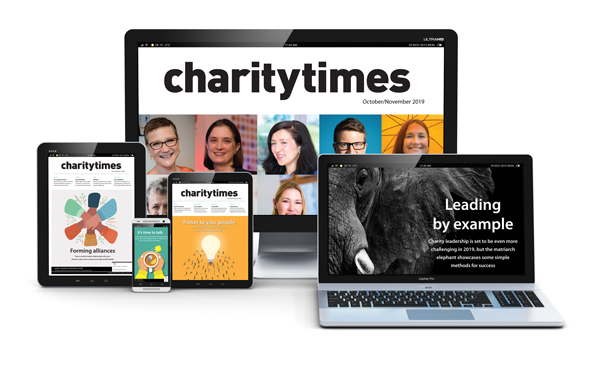Responding swiftly to the housing needs of asylum seekers in Barrow in Furness and supporting young people’s mental health in Sandwell are among the best charity and council partnerships in the country, according to a new report.
The seven examples, in areas also including Oldham, Suffolk and Hackney in London, have been listed in a guidance document produced by the Local Government Association (LGA) alongside the National Association for Voluntary and Community Action (NAVCA).
This document advises council officers and councillors to work with local community and charity infrastructure organisations to see where charities can help improve services.
These can help with improving commissioning processes to ensure funding is more effectively distributed.
This includes ensuring services provide support to all residents equitably and local areas can respond quickly to crises.
However, the guide warns that funding for partnerships is scarce due to reduced revenue for both charities and councils in recent years as they also tackle increasing demand for support.
“This resource is therefore published within this complex and difficult environment for all,” the LGA says.
Voluntary, community and social enterprise organisations are effective partners in delivering shared ambitions for local communities and residents.
— Local Government Association (LGA) (@LGAcomms) September 17, 2024
Our new guide sets out practical steps councils can take to work with those organisations 🤝 https://t.co/OZVPpMn44P
The guide also focuses on ways councils and charities can tackle barriers stopping effective partnerships.
These can be “actual or perceived” and often arise “when there is a lack of trust openness or poor communication. Lack of time, resources and funding can also hinder relationships.
Being called for is greater openness between councils and charities to tackle their “lack of knowledge and understanding” of how they work and their capacity. Such understanding should help to address unrealistic expectations councils put on charities, such as assuming their services are free.
Similarly, being more open will tackle charities “unrealistic expectations” on councils that funding, and officer time, will always be available.
The guide highlights six pieces of advice to ensure barriers to effective partnership working are tackled. Councils and charities are being called on to:
• foster trust between all parties
• co-produce activities and outcomes
• understand of the strengths, expectations and limitations of each party
• open clear communication so that difficult conversations can take place
• a council recognising that they hold more resources and power
• charities recognising that they are often able to act with greater flexibility than councils.
Here we showcase the seven areas of strong local partnership working across England highlighted in the report where many barriers impacting charity and council relationships are being effectively tackled.
Trusted relationships in Oldham
This partnership combines council officer and charity worker expertise to support the needs of global majority communities in this area of high deprivation.
The LGA says this link up demonstrates all six of its areas of advice to charities and councils to tackle barriers getting in the way of effective working (see above).
Involved are local infrastructure organisation Action Together CIO working with the council to respond to the cost-of-living crisis and ensure help through the Household Support Fund is distributed rapidly to families most in need.
This partnership benefits from Action Together having a well-established long relationship with the council, which both sides describe this as being “open, honest and trusted”.
“This allows for rapid and flexible working, the ability to disagree, and challenge when things go wrong,” says the LGA’s guide.
Action Together takes a “relational approach to its work” with local charity, faith and community groups, it adds. This focuses on £building relationships to understand the objectives and aspirations of grassroots groups as well as support their needs”.
Co-designing funding processes with local charities helps this partnership.
As does a streamlined governance structure headed by a senior council officer, who is able to take decisions quickly.
Minimising power imbalances in Suffolk
Councils are being urged by the LGA to ensure they can minimise power imbalances when forming partnerships with local charities. The guide advises both parties meet and discuss issues in places where they have equal footing.
Among areas doing this is Suffolk, which has the added challenge of having a two-tier local government structure across a large rural area.
Here small charity infrastructure organisation Collaborative Community Board (CCB) has created a space for council, health and charity representatives to come together.
The CCB was set up during the pandemic but has carried on due to its success in bringing together charities and council representatives to tackling issues such as poverty and loneliness.
The LGA says that the CCB “is an example of the benefits that accrue from investing in relationships”.
“It is comparatively simple with one board that provides strategic oversight, can target work to areas of most need and enables the allocation of funding from several sources to the right place at the right time.
“The subgroups provide a flexible and agile response to presenting issues, and prevents duplication and competition between councils, statutory sectors” and charities.
Supporting asylum seekers in Barrow in Furness
Charities and representatives from the then Cumbria County Council and Westmorland and Furness Council, which launched in May 2022, have been working together to effectively support the housing needs of asylum seekers.
Their work got underway two years ago when an asylum contingency hotel opened in Barrow in Furness.
The residents needed support but for many local community organisations this was a new area of work.
To ensure this support was effectively coordinated the council and local charity infrastructure organisations held frequent online meetings with flexible agendas focused on problem solving and building relationships.
Top level decision making was able to be taken by a senior council manager through this focus. In addition, local charities and community groups have been able to support the needs of hotel residents effectively.
Involved in coordinating support was Furness Multicultural Community Forum, a small organisation that supports people from diverse backgrounds and seeks to build community cohesion.
This group was instrumental in being able to “convince other” community organisations to help. Work included staging activities in the hotel and helping the residents orientate to living in the UK, with a focus on community volunteering, as well as through sports and cooking events.
“The approach of frequent, short meetings attended by a senior decision maker with local knowledge and relationships”, should be replicated nationwide in charity and council link ups focused on rapid support projects, says the LGA.
Improving young people’s mental health in Sandwell
Councils have a statutory duty to support children and young people in their area, while charities often have greater expertise in offering specific support, particularly on issues such as mental health problems.
Such problems for children have been especially prevalent since the Covid pandemic when they endured months of lockdown.
Sandwell Metropolitan Borough Council and Sandwell Council of Voluntary Organisations (SCVO)’s partnership is a strong example of how charities and councils can work together to support the emotional wellbeing of children, says the LGA’s report.
This involved SCVA being recruited by the council as a partner to manage £1m in government mental health funding.
The partnership saw SCVO talk to schools and charities about specific mental health problems impacting children and offering grants to charities and groups for up to £40,000 to support children.
The SCVO used independent evaluators to monitor the project and charities undertaking the work “were not asked to fit into a particular shape or approach to service delivery but to play to their strengths”.
Senior leaders and experts from across the council, health partners and charities were involved in a “high level steering group”, which was chaired by the SCVO’s chief executive.
Since then, two further waves of funding have been delivered to enable charities to support young people with their mental health.
Evaluation found that isolation, anxiety reduced among local young people through funded projects. Confidence and self-esteem, resilience, and child protection also improved.
The partnership has helped to strengthen links between charities and the council as well as local schools, according to the LGA.
Grant distribution in Hackney
Another area where councils and charities are working well together to distribute funding to help communities is in Hackney.
This involves London Borough of Hackney and Hackney Giving, a funding distribution organisation run by Hackney Community and Voluntary Service (CVS).
By working together, the council has been “able to change the way small” charities work with the council; by ensuring they target funding at the most hard to reach communities.
The council’s partnership with Hackney Giving means application forms and processes for local charities have been simplified. Monitoring and reporting procedures have also been simplified.
Another important part of this partnership has been to ensure that project funding covers back office costs and overheads for charities.
Grants have included combating fuel and food poverty, providing children’s activities and supporting for cancer patients.
“The established trusted relationship between the council and Hackney Giving has extended the reach into communities furthest from council services, says the LGA.
“By working more closely together in a trusted relationship outcomes for residents have been improved, with a focus on doing what is best for them rather than serving organisational needs.”
Rebuilding trust in East Riding
The relationship between East Riding Council and charities in the area became strained six years ago, when charity and community organisation Community Vision lost the contract to provide local support infrastructure services in the area.
This saw it continue to engage with the council despite Community Vision having to withdraw from strategic boards and relationships.
However, during the pandemic and subsequent cost of living crisis the council needed to improve its support for charities to ensure they could provide swift support to communities, particular those running foodbanks.
During this time Community Vision “worked to rebuild the relationship with the council, by refusing to hold a grudge” and still help deliver other contracts and services. This took place even though Community Vision had to restructure and diversify its income streams.
This work to rebuild trust has seen Community Vision be invited by the council to participate in strategic forums even though this work was unfunded.
Work by Community Vision amid this relationship building has included supporting local food bank partnership East Riding Food Poverty Alliance develop from being an informal collaboration to become an independent charity.
Helping the hardest to reach in Cambridge
Collaboration following the Covid pandemic to boost vaccinations among hard-to-reach groups helped foster long running partnership working for charities and Cambridge City Council, according to the LGA.
This partnership working increased in 2022 when central government funding was made available to help councils improve uptake of Covid vaccination.
This saw the council work with Cambridge CVS to ensure all communities had information they needed to take decisions around receiving the vaccine.
Elements of this work included all charities and other taking part signing up to an agreed list of shared values, including a commitment to openness and transparency and providing regular feedback to each other.
Another organisation involved is Cambs Youth Panel, to ensure the voice of young people was being heard around issues linked with vaccination.
The partnership succeeded “because its primary aim was about breaking down barriers to vaccination and wider healthcare using non-traditional methods of promoting health interventions”, the LGA found.
“It also led to improvements in wellbeing and mental health. Any increase in vaccination uptake was a byproduct of this focus.”
Since then charities and council have collaborated on further measures to tackle health inequality, produced an equalities toolkit for local charities and provided specific support for young people and families during the cost of living crisis.













Recent Stories